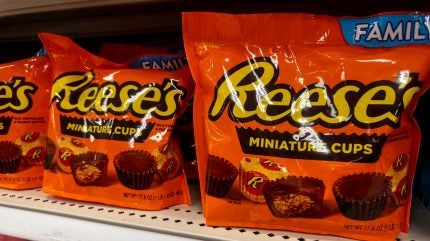
Hershey is expecting “significant pressure on earnings” in 2025 from stubbornly high cocoa costs but still envisages an acceleration in sales revenue.
As cocoa prices hover near December’s record highs, however, the chocolate and salty snacks maker said net pricing will be the “primary” driver behind Hershey’s “at least” 2% growth outlook versus the 0.3% reported for 2024.
The US giant took pricing of 3% in fiscal 2024, an average from a 4% increase in North America confectionery and 2% for its international business, while the salty snacks division in North America took a 1% cut.
Volume/mix reacted accordingly, down 4% and 1%, respectively, for the former two segments, and up 5% in snacks, Hershey reported yesterday (6 February).
Despite pricing in chocolate, the Reese’s brand owner has seen elasticities hold up, and is baking in a historical minus 1% average impact across the portfolio on volumes. Similar actions by competitors are also helping.
“While we continue to view today’s high cocoa prices as transient, our teams are readying opportunities for quick execution, and we are prepared to adjust our pricing, price-pack architecture, formulations, demand-shaping, and investment strategies, should our view on the commodity markets evolve,” chairman and CEO Michele Buck told analysts.
Buck, who plans to step down in June next year after eight years, said private-label players in confectionery have also been “aggressive” with their pricing.
She explained the thinking behind minus one: “We always say we look at the impact of pricing – and there is a volume-conversion curve that you go on once you price – and then we build back up from there relative to the programming that we have to unlock growth and consumption on the brand.
“We do that on a pack-by-pack and a retailer-by-retailer, brand-by-brand [basis], and that’s really what helps us get to what that number looks like.”
The CEO suggested diversify in cocoa supply will help address imbalances as she expressed an element of positivity that the cost of the commodity will eventually retreat.
“We continue to feel good about what we’re seeing in the market fundamentals. We’re continuing to see production increase with nearly half of the production today coming from areas outside of Ivory Coast and Ghana. We think that’s really healthy for the global cocoa supply over time,” Buck explained.
“It’s going to be much more diversified and that diversification is going to provide an inherent resilience, just balancing weather factors and geopolitical factors, etc.”
Hershey on reformulation
The question of reformulation popped up on yesterday’s analyst call as a counterweight to elevated cocoa prices, but while Buck said Hershey has embraced that approach to a certain degree, taste is still key.
“We have been seeing some increased global demand across the market for cocoa alternatives. We are seeing some folks who are pressured who perhaps have the opportunity to switch to cocoa butter alternatives,” she said.
“Obviously, we do that where possible, but we’re pretty precious about the brands and what they stand for with consumers.”
The increasing use of the GLP-1 weight-loss or obesity drugs in the US is also not having a “material impact” on Hershey, a similar observation made this week by its peer in the salty snacks category, PepsiCo.
“We have multiple data sources that also support our view that users of the drugs do not eat disproportionately less of our categories,” Buck said.
“We do know that there’s a broader shift in consumer preference for healthier items. That has been underway for some time, items that have nutritional claims around low sugar and other things, and we will continue to evolve our portfolio as we continue to track what’s important to consumers.”



